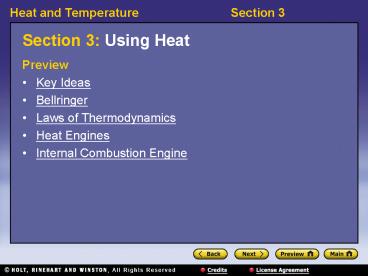Section 3: Using Heat - PowerPoint PPT Presentation
1 / 9
Title:
Section 3: Using Heat
Description:
Title: No Slide Title Last modified by: zeenat.rentia Document presentation format: On-screen Show Other titles: Times Arial Arial Unicode MS Custom Design Section 3 ... – PowerPoint PPT presentation
Number of Views:76
Avg rating:3.0/5.0
Title: Section 3: Using Heat
1
Section 3 Using Heat
- Preview
- Key Ideas
- Bellringer
- Laws of Thermodynamics
- Heat Engines
- Internal Combustion Engine
2
Key Ideas
- What happens to heat energy when it is
transferred? - What do heat engines do?
3
Bellringer
- According to the law of conservation of energy,
energy is never created or destroyed. But energy
does change forms and can be transferred. Use
these ideas to answer the following questions
about how a car works. - As an automobiles air conditioner cools the
interior of the car, what happens to the energy
from the warm air inside the car? - In terms of chemical and mechanical energy,
explain why a running car engine gives off heat. - How is heat given off by a running car engine
related to the usable energy inside the engine?
4
Laws of Thermodynamics
- What happens to heat energy when it is
transferred? - The first law of thermodynamics states that the
total energy used in any process is conserved,
whether that energy is transferred as a result of
work, heat, or both. - The second law of thermodynamics states that the
energy transferred as heat always moves from an
object at a higher temperature to an object at a
lower temperature.
5
Laws of Thermodynamics
- Work can increase average kinetic energy.
- mechanical processes processes in which energy
is transferred by work - The disorder of a system tends to increase.
- Over time, in any given system left to itself,
the entropy of that system will tend to increase. - entropy a measure of the randomness or disorder
of a system - Usable energy decreases in all energy transfers.
- If entropy increases, less energy is in a usable
form. - Conduction and radiation may cause energy to be
transferred to the surrounding.
6
Heat Engines
- What do heat engines do?
- In a heat engine, potential chemical energy and
internal kinetic energy are converted to
mechanical energy by the process of combustion. - heat engine a machine that transforms heat into
mechanical energy, or work - Internal-combustion engines and
external-combustion engines are the two main
types of heat engines.
7
Heat Engines, continued
- Internal-combustion engines burn fuel inside the
engine. - An automobile engine is a four-stroke engine,
because four strokes take place for each cycle of
the piston. - The four strokes are
- intake
- compression
- power
- exhaust
- Internal-combustion engines always generate heat.
- Friction and other forces cause much of the
energy to be lost to the atmosphere as heat.
8
Heat Engines, continued
- Automobile engines use carburetors or fuel
injectors. - A carburetor is the part of the engine in which
liquid gasoline becomes vaporized. - Some engines have fuel injectors instead of
carburetors.
9
Internal Combustion Engine

